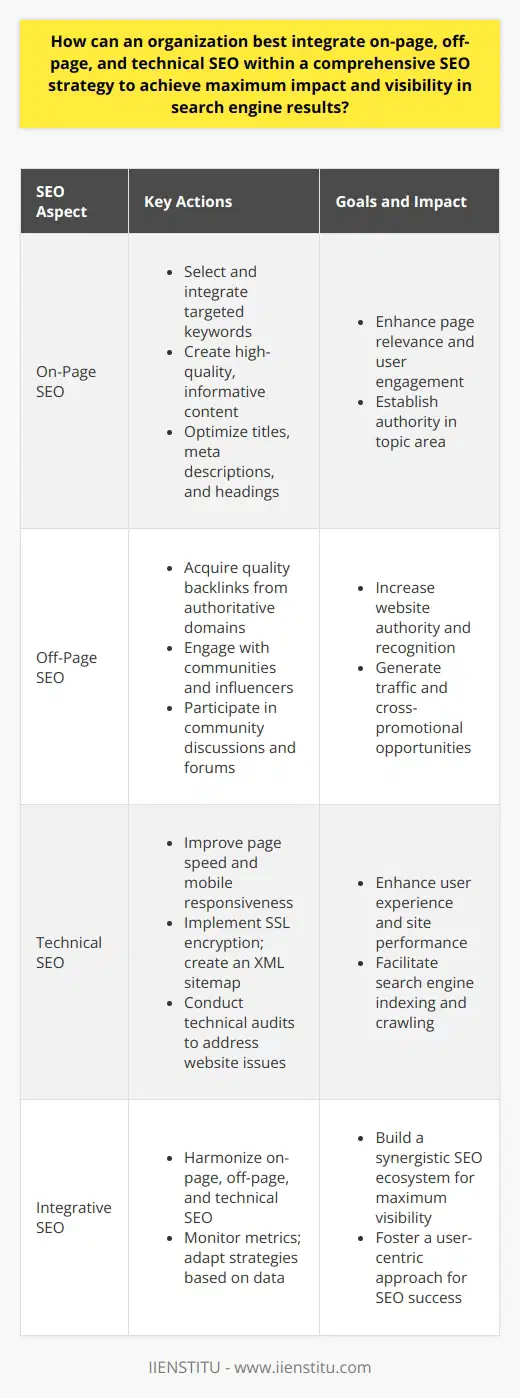
This article discusses the importance of understanding the business, assessing resources, and identifying technical SEO issues to create an effective SEO plan. It is essential to understand the industry, target audience, and products or services offered to identify the most efficient and highest-impact improvements.
Additionally, resources must be assessed to identify potential technical SEO issues and prioritize tactics. Once the fundamentals have been addressed, data can be collected and analyzed to guide the development of a long-term plan. Tracking, measuring, and refining the program on a timeline supported by resources and business objectives is essential.
Finally, it is essential to remember that SEO strategies must be unique to the business and its objectives and to be prepared to adapt to unexpected obstacles.
Introduction
Understanding the Business
Assessing Resources
Identifying Technical SEO Issues
Developing a Long-Term SEO Plan
Introduction: Search Engine Optimization (SEO) is essential to any digital marketing strategy. It helps attract more website visitors by optimizing content for various search engine algorithms and building a solid online presence.
Related Course: Digital Marketing Course
To effectively use SEO for business success, it is essential to understand key concepts such as keyword research, content optimization, link building, social media integration, analyzing website performance data, and technical SEO.
Understanding the Business
Before beginning an SEO plan, it is essential to have an in-depth understanding of the business’s objectives. This requires research on the company’s target audience, competitors in the market, and the current cost structure of its services or products.
This information can help identify areas for improvement in search engine visibility and ensure that resources are allocated appropriately. Additionally, understanding what type of content resonates with customers will help create successful SEO strategies.
Assessing Resources
Once an understanding of the business has been established, assessing resources is paramount to developing successful SEO plans.
This step involves determining how much time and money can be invested into SEO campaigns and what kind of access there is to web development teams or technology partners who can assist with the technical aspects of the project.
Additionally, evaluating existing technology platforms and personnel capabilities can provide insight into how best to develop effective strategies.
Identifying Technical SEO Issues
Identifying technical issues associated with websites is essential for improving website rankings when creating successful SEO plans.
Some standard tools used include Google Search Console and other audit tools that allow users to check page indexing status and detect any errors present on web pages, evaluate page load times, analyze site structure, review crawl ability, assess internal linking systems, see broken redirects, audit page titles & meta descriptions, analyze user experience (UX) factors such as page layout & navigation menus, evaluate mobile-friendliness & usability among other things.
All these points should be addressed to ensure optimal performance across all search engines used by potential customers while creating a winning SEO plan.
Developing a Long-Term SEO Plan
The final stage of creating a successful SEO plan involves developing long-term strategies that will yield sustainable long-term results.
Strategies should focus on producing valuable content that aligns with marketing goals, building relationships with influencers within target markets through guest blogging or collaborations, increasing brand awareness through social media campaigns or paid advertising, identifying opportunities for link building from reputable sources both internally & externally, maintaining technical standards across all web pages & regularly monitoring website performance data from analytics tools like Google Analytics or AdWords are just some examples of tasks needed when constructing long-term plans for success using search engine optimization techniques.
By understanding the current business objectives, assessing resources, identifying technical SEO issues, and developing a long-term SEO plan, businesses can create successful SEO plans that will help boost their visibility online and improve their overall bottom line.
Conclusion: Creating a successful SEO plan requires taking the time to understand your business objectives, assessing available resources, identifying technical issues, and developing long-term strategies. When done correctly, these efforts can help improve website visibility online and boost overall revenue for businesses of all sizes. Following the tips outlined in this article, you can craft an effective search engine optimization strategy that helps take your business goals from concept to reality. With commitment and dedication, you’ll soon find yourself reaping the rewards of improved rankings on SERPs and increased customer engagement with your brand or products.
Key Takeaways:
• Understand the business objectives before creating a successful SEO plan.
• Assess resources and identify technical issues to develop effective strategies.
• Develop a long-term SEO plan focused on producing valuable content, building relationships with influencers, increasing brand awareness through social media campaigns, and identifying opportunities for link-building from reputable sources.
• Commitment and dedication are needed to ensure success when creating an SEO plan. With the right approach, businesses of all sizes can reap the rewards of improved rankings on SERPs and increased customer engagement with their brand or products.
SEO success requires a willingness to learn and the ability to anticipate trends.
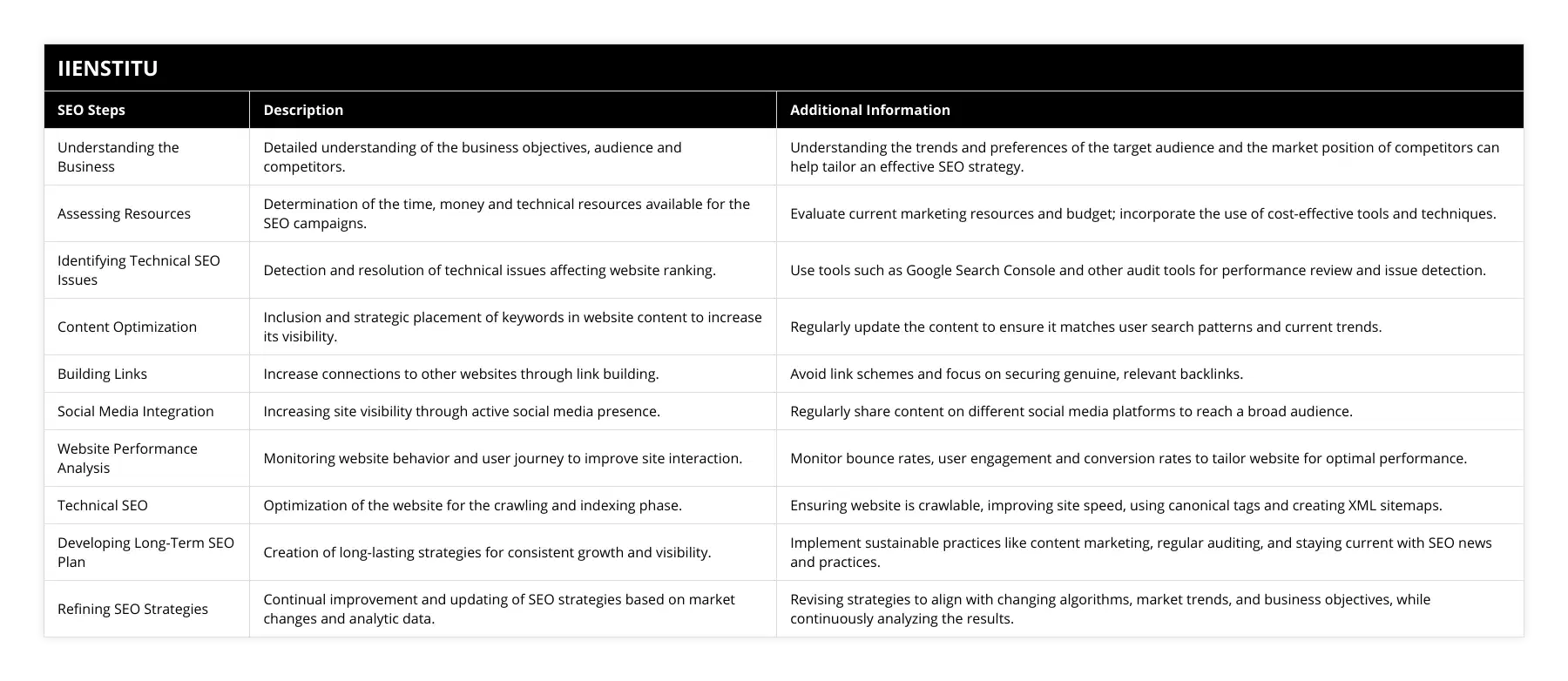
Frequently Asked Questions
What are the key steps in creating a successful SEO plan?
When it comes to digital marketing, search engine optimization (SEO) plays a vital role in the success of a business. To ensure that you are optimizing your website for the best possible results, creating a successful SEO plan is essential.
The first step in creating an effective SEO plan is to conduct an SEO audit. An SEO audit will help you identify potential areas of improvement, such as keyword optimization, content optimization, and technical SEO. Once you have identified the areas you would like to improve, you can create a list of actionable steps to improve your website.
The second step in creating a successful SEO plan is to define your goals and objectives. This will help you focus your efforts on your business's most beneficial areas. Again, it is essential to be realistic with your goals and objectives and to ensure they are achievable.
The third step in creating a successful SEO plan is to create a keyword strategy. This involves researching and selecting the best keywords for your website. Choosing keywords that will be highly relevant to your target audience and have a high search volume is essential. Once you have identified the best keywords for your website, you can optimize your content for those keywords.
The fourth step in creating a successful SEO plan is to monitor and analyze your website’s performance. This will help you identify areas of improvement and determine whether your SEO efforts have the desired effect. Additionally, staying up to date with the latest trends and developments in the world of SEO is essential.
Finally, creating a successful SEO plan requires ongoing maintenance. This includes regularly updating your content, monitoring your website’s performance, and staying up to date with the latest trends and developments in SEO. Additionally, monitoring your competitors and ensuring you stay ahead of the curve is essential.
Creating a successful SEO plan is a complex and time-consuming process. However, with a clear goal, you can ensure that your website is optimized for the best possible results. By following these steps and staying up to date with the latest trends and developments in SEO, you can ensure that your website is performing well and achieving the desired results.

How can understanding the business help create an effective SEO plan?
SEO has become essential to any successful business’s marketing plan in today's digital world. SEO, or Search Engine Optimization, is a set of strategies and tactics used to increase a website's or page's visibility in search engine rankings. Understanding the business is critical to creating an effective SEO plan and will help to ensure that the plan is tailored to the business’s particular needs and goals.
The first step in creating an effective SEO plan is understanding the business’s primary goals. What does the company want to achieve? Is the focus on increasing online sales? Improving website traffic? Generating leads? Knowing the desired outcome is necessary to create an SEO plan that will most effectively achieve those goals.
Once the business’s goals are known, the next step is understanding the target audience. What type of people is the company trying to reach? Who is the typical customer? Learning this information will help determine which keywords should be used to optimize the website’s visibility in search engine rankings.
In addition, understanding the business will help to identify the most effective strategies and tactics to use in the SEO plan. For example, if the company aims to increase website traffic, the SEO plan should focus on link building, content creation, and social media optimization. On the other hand, if the goal is to generate leads, the plan should focus more on optimizing local search, creating engaging content, and utilizing PPC (pay-per-click) campaigns.
Finally, understanding the business will help to ensure that the SEO plan is tailored to the business’s particular needs and goals. By clearly understanding the business’s objectives and target audience, the plan can be customized to maximize the effectiveness of the SEO efforts.
In conclusion, understanding the business is essential in creating an effective SEO plan. Knowing the business’s goals, target audience, and the most effective strategies and tactics will help ensure that the plan is tailored to the business’s needs and goals. With a comprehensive and customized SEO plan, companies can maximize their visibility on search engine rankings and reach their desired goals.
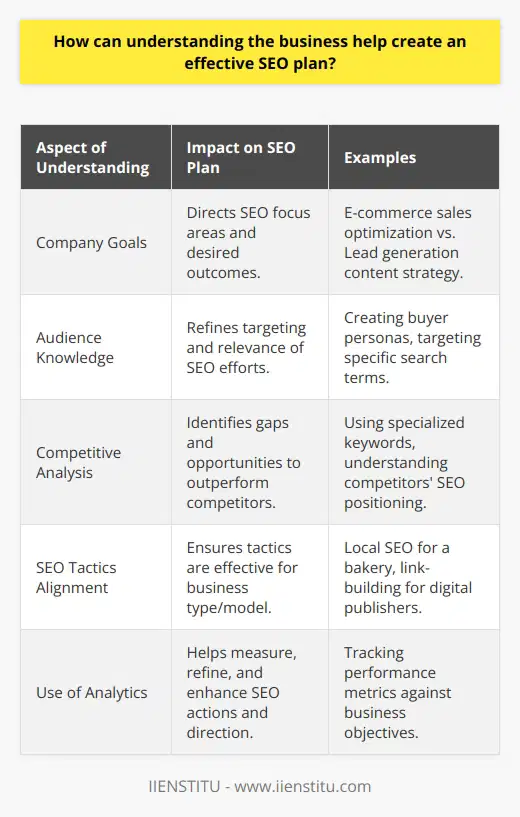
What resources should be assessed when developing an SEO plan?
When developing an SEO (Search Engine Optimization) plan, it is essential to assess the resources available to maximize its effectiveness. Several vitalizing resources should be considered, including keyword research, content optimization, link building, and analytics.
Keyword research involves the identification of relevant search terms and phrases that potential customers are likely to use when searching for a product or service. It is essential to use the right keywords to target the right customers and ensure that the company’s website appears in search engine results. Keyword research should include a thorough analysis of both short-tail and long-tail keywords to maximize the effectiveness of the SEO plan.
Content optimization is optimizing website content to make it more visible to search engines. This includes the use of relevant keywords, as well as creating compelling titles and descriptions for each page of the website. Therefore, ensuring that all content is optimized is essential to maximize the website's visibility.
Link building is obtaining high-quality links from other websites that can be directed to the company’s website. These links can be acquired through guest blogging, directory submissions, and other methods and should be included in the SEO plan to increase the website's visibility.
Finally, analytics should be utilized to track the progress of the SEO plan and measure the effectiveness of the strategies implemented. Analytics can provide valuable insights into the website's performance and the point of the SEO plan. This information can be used to adjust the plan to maximize its effectiveness.
In conclusion, keyword research, content optimization, link building, and analytics are all essential resources that should be assessed when developing an SEO plan. Utilizing these resources can help to ensure that the SEO plan is effective and that the website is visible to potential customers.
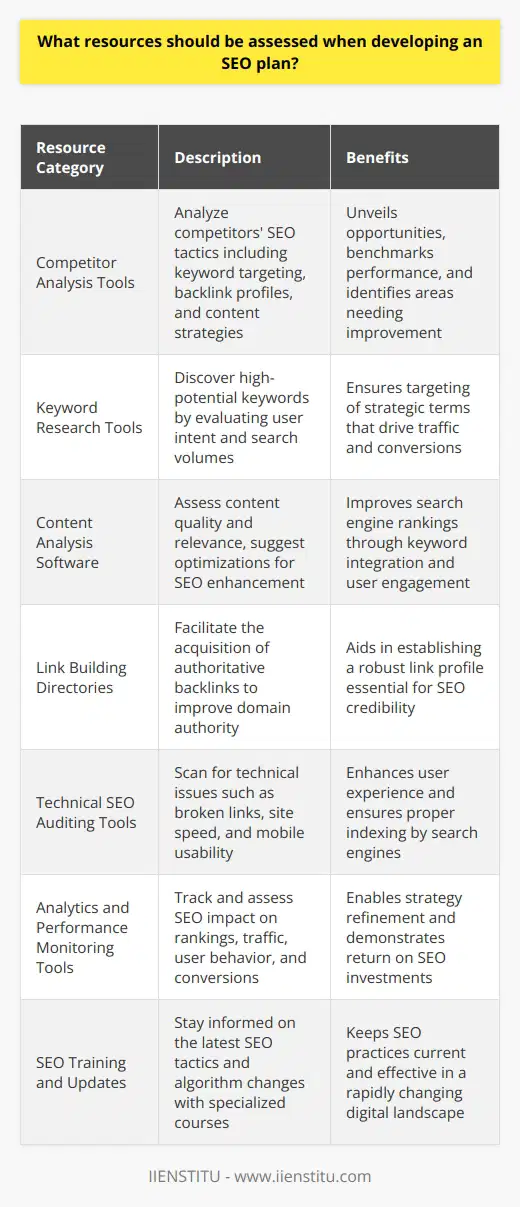
How do I create a SEO strategy plan that aligns with my organizational goals?
Understanding Organizational Goals
To create an SEO strategy plan that aligns with an organization's goals, it is crucial to first understand the objectives the organization wishes to achieve. These goals may include increasing brand awareness, generating leads, improving customer engagement, or driving sales. By identifying these goals, an SEO plan can be developed to support the organization's overall mission and vision.
Keyword Research and Selection
An essential aspect of an SEO strategy is identifying relevant keywords that target the desired audience and represent the core of the organization's offerings. Conducting comprehensive keyword research enables the selection of high-potential keywords that align with the organization's goals. These keywords should be relevant, have high search volume, and exhibit low competition to ensure optimal visibility and ranking on search engine results pages (SERPs).
On-Page Optimization
With a list of targeted keywords, the SEO strategy should include on-page optimization by incorporating these keywords into the website's content, meta titles, meta descriptions, and header tags. Additionally, structured data, image optimization, and mobile-friendliness should be prioritized to improve user experience and facilitate search engine indexing. These optimization efforts will enable search engines to better understand the site's content, thus driving organic traffic that aligns with the organization's goals.
Content Creation and Marketing
Creating high-quality, engaging, and informative content plays a significant role in aligning an SEO strategy with an organization's objectives. By producing content that addresses the target audience's needs, questions, and concerns, the organization positions itself as a thought leader, builds trust, and establishes authority in its industry. Moreover, sharing this content on social media platforms, reputable forums, and guest blogging opportunities can garner valuable inbound links, enhance visibility, and strengthen brand reputation.
Measuring and Analyzing Performance
Finally, an integral component of a successful SEO strategy is regularly measuring and analyzing the performance of the implemented initiatives. By monitoring key performance indicators (KPIs) such as organic traffic, conversions, click-through rates (CTR), and bounce rates, the effectiveness of the SEO plan can be evaluated against the organization's objectives. These insights can be utilized to identify areas of improvement, implement necessary adjustments and ultimately, ensure the SEO strategy's ongoing alignment with the organization's goals.

What are the essential components to include in an SEO action plan for long-term success?
Keyword Analysis and Selection
An SEO action plan's first essential component is keyword analysis and selection, which involves researching and identifying relevant keywords that target audiences are likely to use when searching for information or products. The selected keywords should be incorporated into the content, meta tags, headings, and URLs to improve visibility and search engine rankings.
Competitor Analysis
The next critical component in an SEO action plan is competitor analysis. This step consists of examining and evaluating the SEO strategies employed by competitors in the same industry or niche. By understanding their strengths and weaknesses, businesses can capitalize on opportunities and avoid potential pitfalls, resulting in better optimization and higher search rankings.
On-Page Optimization
On-page optimization is essential for boosting a website's SEO performance. This includes optimizing meta tags, such as the title, description, and header tags, ensuring proper keyword usage, and improving content quality by making it informative, relevant, and engaging. Additionally, interlinking relevant content within the website helps search engines better understand and index the site, further optimizing it for higher rankings.
Off-Page Optimization
Off-page optimization refers to all efforts made to increase visibility, authority, and credibility outside the website itself, such as link-building and social media marketing. Businesses must engage in link-building strategies to obtain high-quality, relevant backlinks from reputable sources to improve their site's overall authority, which heavily influences search engine rankings. Social media platforms can also contribute to increased traffic, visibility, and engagement, ultimately benefiting the website's SEO performance.
Technical SEO
Technical SEO comprises optimizing a website's structure, code, and other elements that affect search engine crawlers' ability to access, understand, and index the site. Key aspects of technical SEO include improving site speed, ensuring mobile-friendliness, securing the website with HTTPS, implementing structured data, and addressing crawl errors. A well-optimized website ensures that search engines can efficiently crawl and understand the site's content, contributing to better search rankings.
Continuous Monitoring and Adjustments
Finally, an effective SEO action plan requires continuous monitoring and adjustments to maintain and improve the website's performance. Regularly tracking and analyzing site metrics, such as organic traffic, click-through rates, and keyword rankings, can provide valuable insights and identify areas for improvement. This allows businesses to adjust their strategies, optimize their content and website structure, and ultimately achieve long-term SEO success.
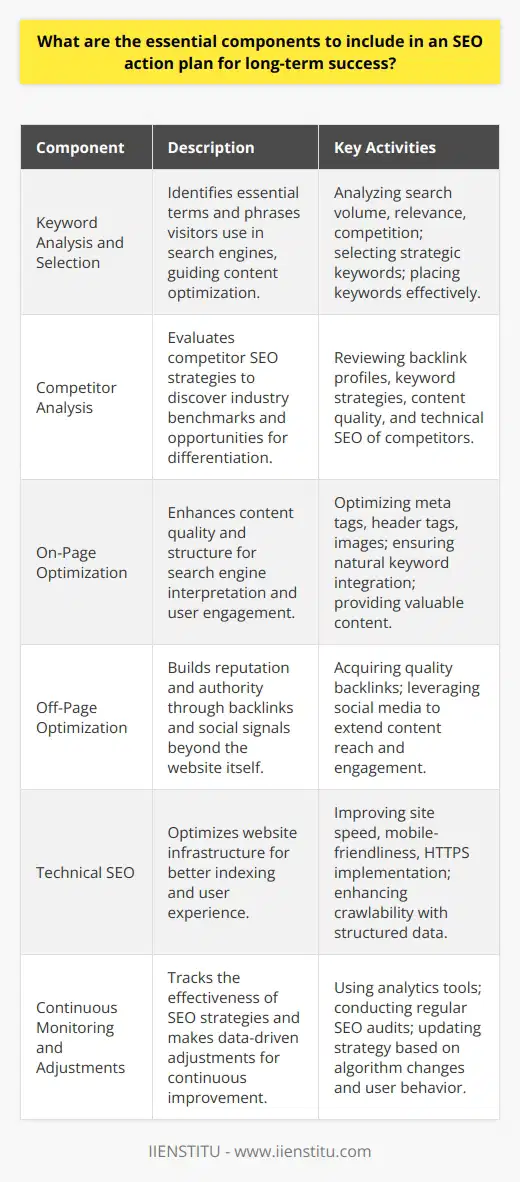
How can I continuously adapt and improve my SEO strategy to stay ahead of the competition in 2023?
Adapting SEO Strategy in Response to Algorithm Updates
To continuously adapt and improve one's SEO strategy in 2023, it is crucial to stay informed about the latest updates and changes in search engine algorithms. Google, for example, frequently updates its algorithms to deliver more relevant and valuable search results. Consequently, optimizing a blog post according to these updates will enable it to outrank competitors that are slow to adapt.
The Importance of Conducting Keyword Research
A critical component of any successful SEO strategy is keyword research. By identifying the most relevant and high-traffic keywords related to the blog post topic, it becomes possible to optimize the content accordingly. Regularly updating this research will allow an SEO practitioner to keep up with the evolving search terms and trends, ensuring that the blog post retains its search visibility.
Optimizing Content for Voice Search and Featured Snippets
As user preferences change and technology evolves, alternative search methods like voice search and featured snippets are becoming increasingly popular. Ensuring the blog post content is optimized for both voice search and featured snippets will help maintain its ranking and visibility. This involves structuring the content logically, using headers, and answering frequently asked questions concisely.
Leveraging Social Media for SEO Benefits
While social media signals might not directly impact search engine rankings, there is considerable evidence suggesting a correlation between social media presence and search visibility. A blog post that receives a high amount of engagement, shares, and links on social media platforms is likely to be perceived as valuable by search engines. Therefore, focusing on a robust social media marketing strategy has indirect SEO benefits and will contribute to staying ahead of the competition.
Continuous Monitoring of Competitors' Strategies
Lastly, continuously monitoring and analyzing competitors' SEO strategies will provide valuable insights and ideas. This includes examining the keywords they are targeting, the content they are producing, and the backlinks they acquire. By actively keeping track of competitors' performance and tactics, it becomes possible to develop a more effective and adaptive SEO strategy that stays ahead of the competition.
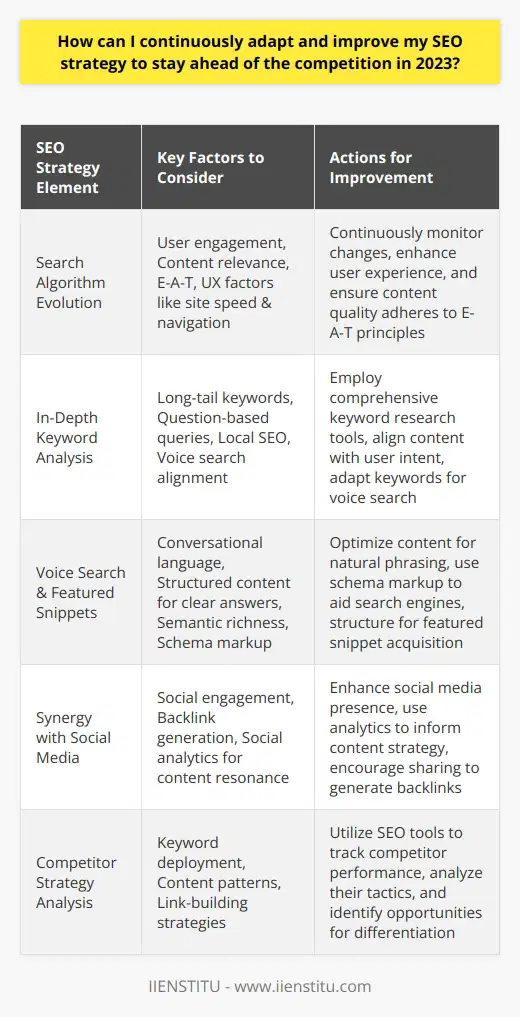
How do I create a SEO plan that effectively targets my desired audience?
Understanding your Audience
Creating an effective SEO plan begins by understanding your target audience. Determine their preferences, challenges, and what solutions they seek. This aids in crafting relevant content that meets their needs.
Keyword Research
Begin with thorough keyword research. Identify keywords that your audience uses when searching for information or solutions related to your blog's focus. Use SEO tools such as Google's Keyword Planner or SEMrush to simplify this process.
SEO Optimized Content
Create high-quality, SEO-optimized content around these keywords. Ensure it provides value to your audience and prompts them to return. Remember, SEO is not just about search engines, but also about providing a user-friendly experience.
On-page Optimization
On-page SEO techniques refer to optimizing individual blog posts to rank higher and earn relevant traffic. This involves the correct use of HTML tags (title tags and meta descriptions), URL structure, and effective keyword placement.
Off-page Optimization
Off-page SEO tactics help make your blog appear more trustworthy to users and search engines. Such methods include link building, social media marketing, and guest blogging. They contribute to your blog's reputation and visibility online.
Technical SEO
Technical SEO is also crucial. A fast-loading blog, mobile responsiveness, and secure HTTPs protocol not only improves user experience but also signals search engines that your blog is high quality, thus enhancing its rankings.
Analytics and Adjustment
Lastly, continually monitor your SEO plan's progress. Use tools like Google Analytics to track results like keyword rankings, organic traffic, etc. Adjust your strategies based on these metrics to better meet your audience's needs.
In essence, a successful SEO plan hinges upon comprehending your audience, creating worthwhile content, utilizing on-page and off-page SEO techniques, implementing technical SEO practices, and regular analytics monitoring and adjustment.
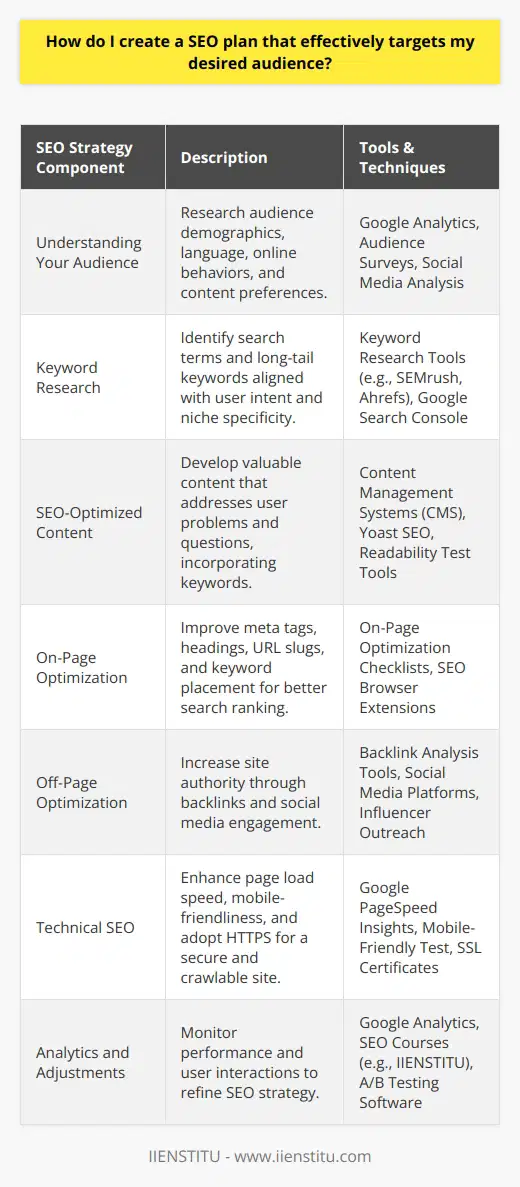
How can I ensure that my SEO strategy in 2023 remains up-to-date with search engine algorithm changes?
Understanding Algorithm Updates
To ensure your SEO strategy remains current in 2023, first understand search engine algorithm updates. Algorithm changes dictate indexing and the ranking of websites.
Regular SEO Training
Invest time in continual learning. Attend training and webinars related to SEO. Read up on industry news and trends. Being well-informed helps adapt your strategy with the updates.
Use SEO Tools
Secondly, use updated SEO tools. These tools assist in staying abreast of ongoing changes. They evaluate your website's performance, helping you make necessary improvements.
Focus on User Experience
Remember to prioritize user experience (UX). Search engines increasingly value UX in their algorithms, thus ensuring high-quality content that fulfills users' needs is essential.
Access Website Analytics
Accessing website analytics will help you monitor your site's performance. By doing this frequently, you can capture changes caused by algorithm updates.
Observe Competitors
Monitor your competitors. Observing their SEO activities can provide insights into new strategies and trends.
Stay Active on Social Media
Activity on social media also matters in 2023. Remaining active and engaging on these platforms can improve online visibility and boost SEO performance.
Seek Expert Help
Lastly, do not hesitate to seek assistance from SEO professionals. They should offer timely advice on how to accommodate new algorithm updates.
By following these steps, you can ensure your SEO strategy in 2023 remains up-to-date despite changes in search engine algorithms.
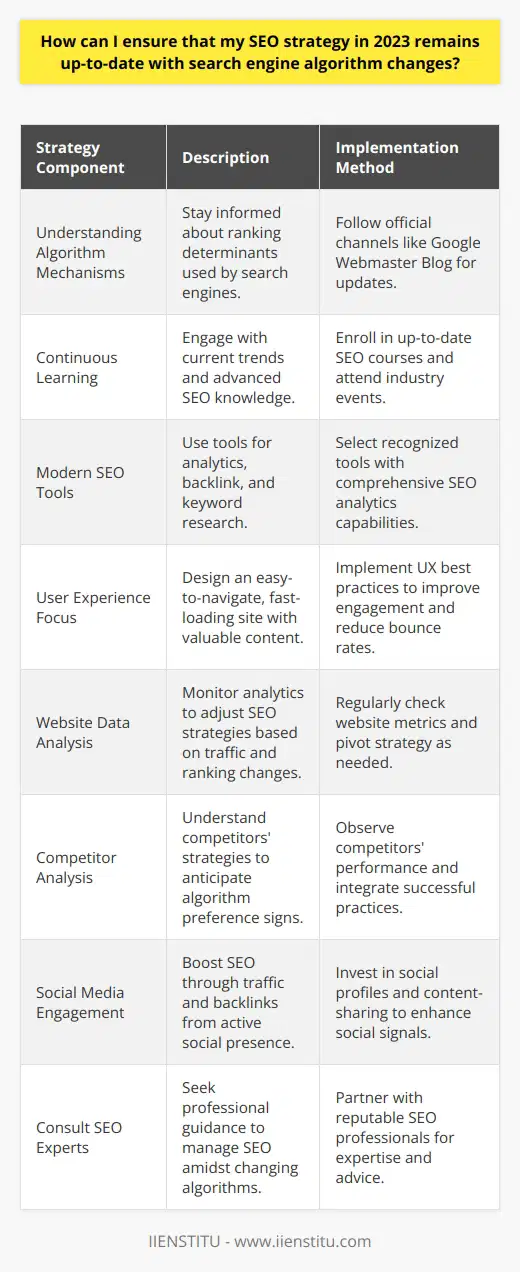
What are some best practices for conducting thorough keyword research as part of an SEO action plan?
Understanding audience intent
The best practices for comprehensive keyword research as part of an SEO action plan include understanding the audience intent. By finding the exact terms users type into search bars, marketers can align their content accordingly. It helps deliver what the audience genuinely seeks.
Implementing long-tail keywords
Incorporating a wider range of long-tail keywords is another crucial practice. These phrases often have a lower search volume, but higher conversion rates. They enable content to focus on a niche audience.
Using keyword research tools
Keyword research tools, such as Google Keyword Planner and SEMRush, bring insights in identifying viable keywords. These tools provide data on keyword competitiveness, search volume, and possible variations. Use this information to refine your SEO strategy.
Analyzing competitors' techniques
Analyzing the strategies applied by your competitors is vital too. Identifying the keywords they rank for provides insights into gaps within your own content. Fill these gaps to improve search engine rankings.
Maintaining keyword relevance
Maintain relevance between keywords and your content. Avoid keyword stuffing. Search engines penalize this. Keeping keywords relevant improves the user experience and enhances the website’s authority.
Reviewing keyword performance
Finally, regularly monitoring the performance of your keywords remains essential. This allows for necessary adjustments to boost rank visibility over time. Google Analytics offers excellent support for this purpose.
Remember, conducting thorough keyword research requires keen attention to shifting trends and user behavior. Stay informed on algorithmic updates. Adapt your strategy as needed to gain better results. 'In-depth keyword research' and 'SEO success' remain inseparable.
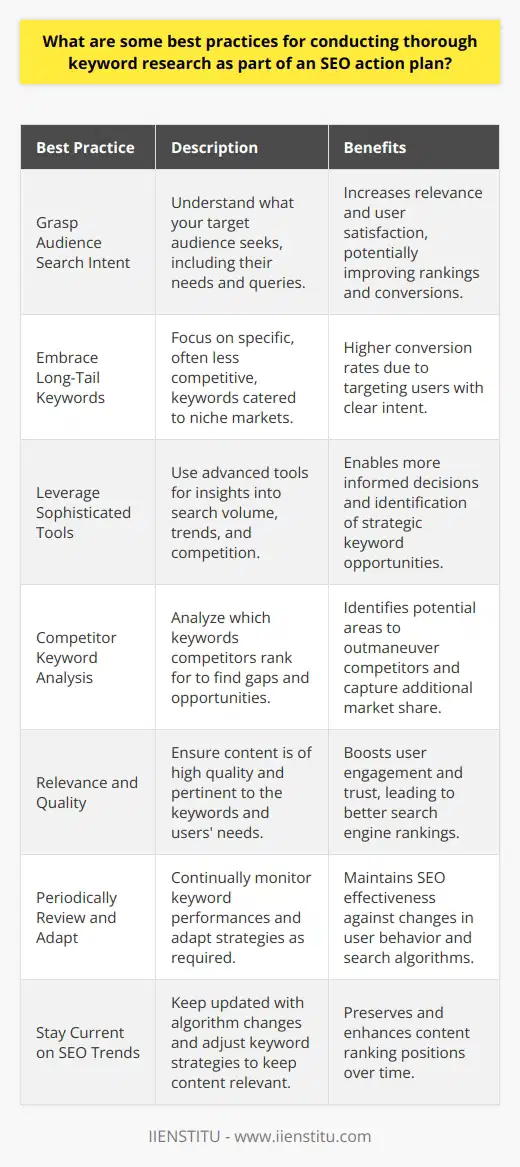
How can I develop a comprehensive SEO action plan that accounts for the evolving digital landscape in 2023?
Understanding Search Behavior
To develop a comprehensive SEO action plan for the evolving digital landscape in 2023, start by understanding the search behavior of your target audience. Look into trending keywords, popular queries, and user intent.
Analyzing Competitors
Don’t forget to analyze your competitors. Find out what strategies they use, which keywords they target, and how they structure their content. Use these insights to improve your SEO plan.
Regularly Updating SEO Plans
An effective SEO strategy requires regular updates. Search engine algorithms and user behavior continuously evolve, making it crucial to monitor changes and update your plan accordingly. Use SEO tools for monitoring purposes.
Adapting to Technological Changes
Stay abreast of technological changes. The advent of voice search, mobile-first indexing, and machine learning have significantly affected SEO. Adapt your brand's SEO strategy in response to these trends.
Creating High-Quality Content
Quality content is still king. Create informative, engaging, and original content that provides value to your audience. Include relevant keywords naturally within the content.
Enhancing User Experience
User experience (UX) significantly influences search rankings. Focus on improving site speed, mobile optimization, and site navigation in your SEO action plan.
Building High-Quality Backlinks
Backlinks signal the credibility of your site. Endeavour to build high-quality backlinks from reputable sources. This process requires networking and creating valuable content worth linking.
Balancing Technical and On-Page SEO
Finally, maintain a balance between technical and on-page SEO. Technical SEO includes site architecture and speed, while on-page SEO involves content and keywords. A combination of both leads to optimized search engine rankings.
In conclusion, a comprehensive SEO action plan for the evolving digital landscape in 2023 encompasses understanding search behavior, analyzing competitors, updating the plan regularly, adapting to technological changes, creating high-quality content, enhancing user experience, building high-quality backlinks, and balancing technical and on-page SEO. With these guidelines, you're better positioned to achieve maximum visibility in search engine results pages (SERPs), improve website traffic, and boost conversions.
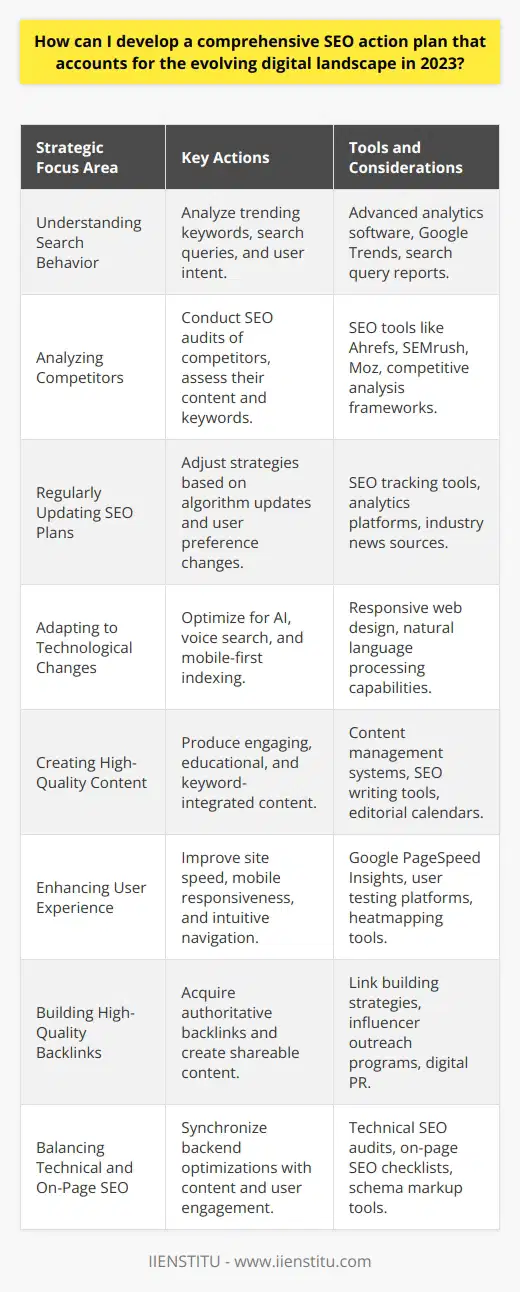
What strategies can be implemented to enhance the effectiveness of an SEO plan, ensuring it remains competitive in the dynamic online environment?
Understanding SEO Dynamics
One effective strategy to enhance SEO plans is regular monitoring and analysis of analytics. This determines if current strategies work or require adjustment to stay competitive.
Incorporating Fresh Content
Another strategy involves regularly updating content with industry-relevant keywords that target demographics use in their online searches. Updated content with well-researched keywords increases website visibility and maintains ranking.
Link-Building Techniques
Engaging in strategic link building also enhances SEO. This technique involves getting external websites to link to your web pages, increasing site authority and trustworthiness.
Utilizing Social Media Platforms
Leveraging social media is also a useful tool. Frequent sharing of content through these platforms aids in driving more traffic, thereby boosting SEO.
Emphasizing Mobile Responsiveness
Given the prevalence of mobile devices, ensuring websites are mobile-friendly is crucial. A mobile-responsive design enhances user experience and improves search engine rankings.
Adopting SEO-Friendly Website Structure
Adopting an SEO-friendly website structure also boost SEO efforts. A clean, well-structured site facilitates search engines’ understanding and indexing of your site, promoting visibility.
Focusing on Unique User Experience
Finally, providing unique user experience ensures visitors stay longer on the site, leading to a reduction in bounce rates and solid SEO boost.
In conclusion, staying abreast of ever-evolving SEO strategies and adapting to these changes can significantly enhance an SEO plan’s effectiveness, ensuring competitiveness in the dynamic online environment.
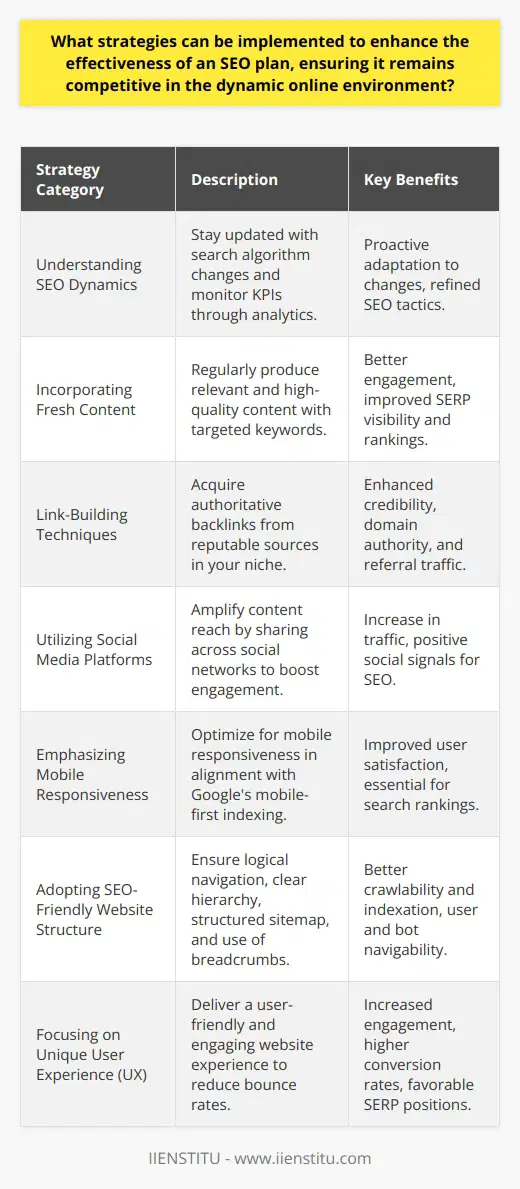
How can I best integrate content creation and technical SEO as part of a holistic SEO strategy for long-term success?
Understanding Integration of Content and Technical SEO
To optimize a blog post for maximum visibility on search engines, integrating content creation and technical SEO forms the bedrock of a comprehensive SEO strategy. At the heart of this integration is the need to produce high quality, relevant content consistently, peppered with strategically chosen and placed keywords.
Role of High-Quality Content
High-quality content draws readers, keeps them engaged, and encourages them to share your blog post. This not only increases your visibility but also potentially improves keyword rankings.
Importance of Keywords
Keywords play a fundamental role within a blog post. They must be strategically placed within your content to satisfy Google's RankBrain algorithm. This algorithm ranks content based on perceived relevance to each user's search intent.
Leveraging Technical SEO
Simultaneously, the technical aspects of SEO should be prudently tackled. This includes optimizing your blog post’s URLs, title tags, and meta descriptions to include the primary keyword. Also, ensure fast loading times and mobile compatibility to provide a seamless user experience, which Google favors in its rankings.
Optimization of On-Page Elements
Moreover, pay attention to on-page elements such as header tags, image alt texts, and internal linking. These features not only make your blog user-friendly but also help search engines understand the context of your page better, thus improving your ranking chances.
Balancing Content and Technical SEO
It is crucial to balance content creation and technical SEO. This includes crafting well-researched, engaging content that resonates with your target audience and ensures all technical aspects of SEO are up to standard. Neither should be compromised - high-quality content is ineffective if search engines cannot find or understand it, just as purely technical optimization cannot make up for poor content.
In conclusion, long-term SEO success necessitates a holistic approach involving the tight-knit integration of both content creation and technical SEO. By fostering this balance, your blog post stands to benefit from increased visibility, traffic, and subsequently, higher rankings on search engines.
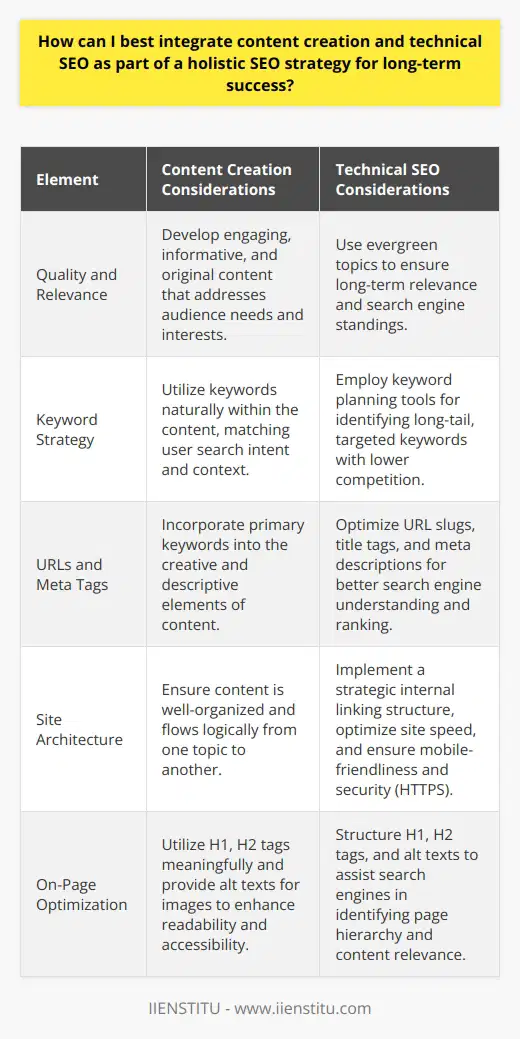
What is the SEO growth strategy and how can it contribute to long-term business success?
Understanding SEO Growth Strategy
The SEO growth strategy primarily involves improving a website's visibility on search engine results pages (SERPs). It particularly focuses on increasing organic or non-paid traffic through superior ranking on search engines like Google.
Contribution to Business Success
In relation to long-term business success, the SEO growth strategy plays a crucial role. It boosts brand visibility, making your brand more accessible to potential customers. Quality SEO strategies also enhance user experience, leading to customer retention and loyalty.
Improved Web Traffic
Implementing effective SEO strategies attracts increased web traffic. By utilizing pertinent keywords and creating quality content, you enhance the chances of your website to rank top in SERPs. As a result, more users can access your site, leading to increased conversions and revenue generation.
Competitive Advantage
Additionally, SEO growth strategies can give a business a competitive advantage. By appearing higher on SERPs, businesses have a better opportunity to reach potential customers before their competitors do. Furthermore, SEO helps businesses to recognize and adapt to the constant algorithm updates, maintaining their competitive edge in the digital business environment.
Cost-Effectiveness
SEO is among the most cost-effective digital marketing strategies. Unlike paid advertising, SEO focuses on organic traffic that potentially has better lead to conversion ratios. Long-term investment in SEO helps businesses save on marketing costs while reaping significant benefits.
Customer Trust and Credibility
Lastly, a strong SEO profile enhances customers’ trust and credibility in a brand. Higher SERP rankings result in positive brand perceptions, influencing users' purchase decisions. In the long-term, this can contribute to sustained customer relationships and loyalty.
In conclusion, the SEO growth strategy, through its capacity to enhance brand visibility, improve web traffic, create a competitive advantage, and foster customer trust, constitutes a key component in ensuring long-term business success.
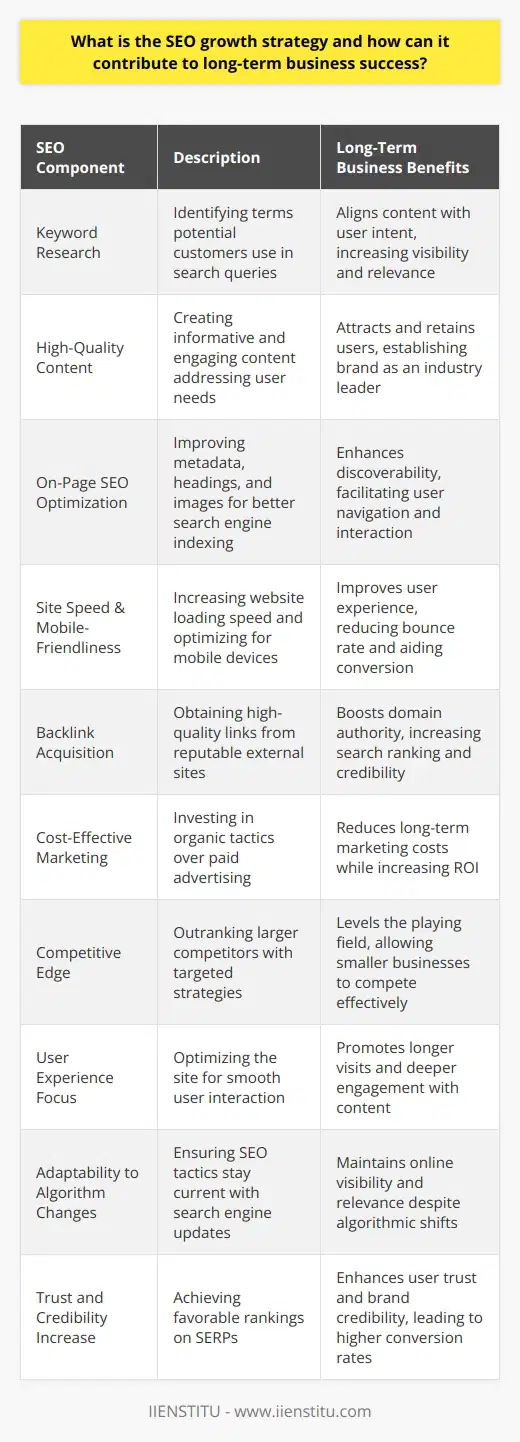
In the context of evolving search engine algorithms, how can an organization maintain an effective and adaptable SEO plan?
Analyzing Trends
Continuous analysis of search engine algorithm trends should be an integral part of an organization's SEO strategy. Deep understanding of these trends lends insights into shifting priorities within search engine algorithms.
Incorporating Adaptability
To accommodate the ever-changing algorithm landscape, organizations should remain adaptable. Adaptability implies a willingness to update SEO strategies in line with new search engine updates or emerging patterns.
Knowledge and Training
To maintain efficacy in their SEO strategy, organizations should invest in continuous learning. Working knowledge of algorithms and SEO must be consistently updated, necessitating regular employee training.
Using Appropriate Tools
Reliable SEO tools should be the cornerstone in managing ongoing SEO performance. Utilizing these tools enables tracking of data-driven insights, subsequent analysis of trends, and the generation of relevant strategic changes.
Quality Content Generation
Despite algorithm changes, high-quality content is a consistent SEO driver. Focusing on creating well-researched, valuable, and original content not only stays relevant through algorithm updates, but also positions a website in higher rankings.
Data Analysis
Using data analytics, organizations should consistently review and monitor their SEO performance. Regular analysis allows organizations to evaluate the efficacy of their SEO strategies, prompting nimble adjustments where needed.
Effectively Engaging Community
Engaging with the online community, through responses to reviews or comment sections, can improve visibility and rankings. This direct communication also provides an opportunity to utilize keywords in the responses without appearing artificial.
Link Building
Building a network of high-quality backlinks to a website is crucial for SEO. Keeping abreast of algorithm preferences, such as a shift to value quality over quantity, equips organizations to adjust their link building strategies.
In summary, a successful SEO plan in an evolving search engine algorithm environment must prioritize adaptability, continuous learning, and the utilization of SEO tools. Commitment to quality content, data analysis, community engagement, and strategic link building also remains crucial.
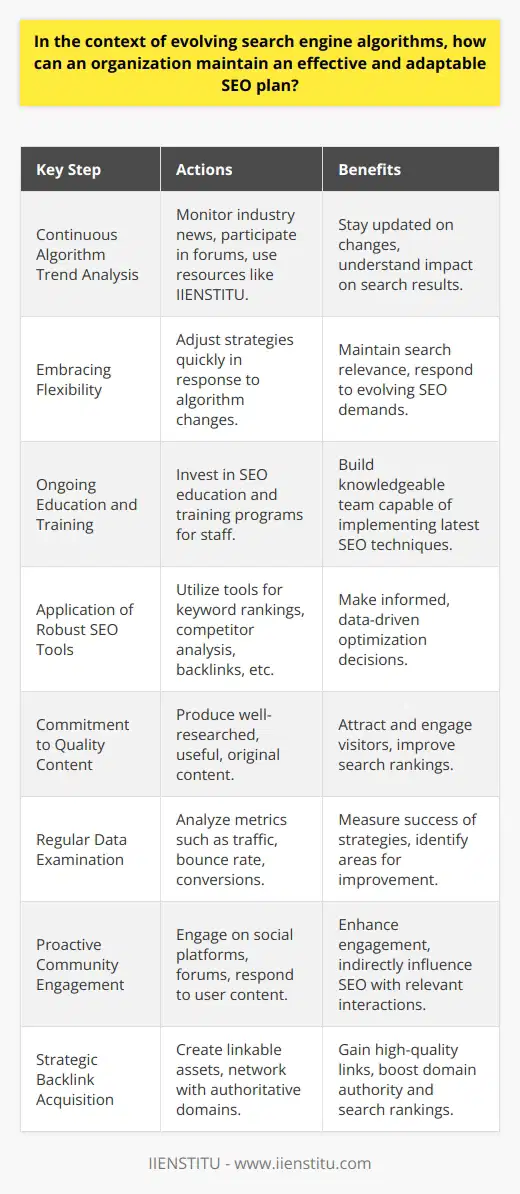
How can an organization best integrate on-page, off-page, and technical SEO within a comprehensive SEO strategy to achieve maximum impact and visibility in search engine results?
Integrating On-Page SEO
An organization can effectively incorporate on-page SEO into the comprehensive strategy through keyword optimization and high-quality content. Keywords strengthen search engine results and responses, hence the organization should include them in headings, URLs, images, and tags. Content quality furthermore plays a pivotal role, employing easily readable language and ensuring the material engages readers.
Incorporating Off-Page SEO
Off-page SEO enhances the website's credibility and popularity, which improves its search engine ranking. Achieving this involves setting up a powerful backlinking practice, involving high-quality and relevant sites linking to your website. Social media promotions and guest blogging can also foster relationships with reputable websites. These efforts enhance organic traffic and visibility.
Optimizing for Technical SEO
Technical SEO requires optimizing the website infrastructure to facilitate search engine scans and site accessibility. The organization can adopt HTTPS to ensure the website has a secure connection. Website speed also impacts SEO significantly, so organizations need to ensure a fast loading speed. Mobile optimization is paramount as the majority of searches occur on mobile devices. Also, creating a sitemap helps search engines understand the organization's website structure.
Seamlessly Integrating all Three
Through a meticulously integrated approach, combining on-page, off-page, and technical SEO, an organization can achieve a holistic strategy. Keyword optimization, better content, and securing backlinks cater to on-page and off-page SEO, while website structure and accessibility address technical SEO. Using these techniques simultaneously not only boosts the pages' visibility but also enhances the user experience, thus maximizing the impact of their SEO efforts.
